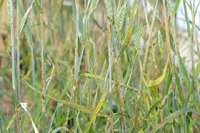Note on May and June articles: Plant pathogens find unique ways of moving from host to host (dispersal). They may use water, soil, vectors, wind, or a combination of these methods. This month, we present the second news item focusing on a unique dispersal method used by some pathogens or their vectors, riding the wind currents (low level jet winds) from the Southern to the Northern Plains. This movement will be occurring through Texas, Oklahoma, Kansas, Nebraska, South Dakota, North Dakota, and the states which border them as you are reading these articles. Watch for evidence or news of these pathogens or other pathogens that ride the wind in your home area.
Wheat (Triticum aestivum) is one of the most important cereal crops grown. Wheat, after milling to produce flour or whole grains, is used to make bread, cakes, cookies, pastries, pastas, breakfast cereals, and many other foods that we eat daily. Wheat is also a staple part of the diet for people around the world. A measure of our world food security and the ability to meet the food demands of the world's population is the world grain stocks. The grain stocks are the amount of food grains stored around the world. In April, it was announced that before the world wheat harvest begins in May, world cereal grain stocks will fall to their lowest level in 30 years. At this time, only enough grain to supply the world for 59 days will remain in storage. Thus, the diseases that affect cereal crops, are especially important to the food supply for the US and the world at this time.
Cereals, such as wheat, are susceptible to many diseases. Many of the pathogens that cause these diseases are wind-borne. Spores of these pathogens are normally very small and may float in the air like dust particles. Wind moves the spores, and when they land on wheat plants and the environment is right, they can infect these plants and cause disease. These pathogens then reproduce on the infected plants producing inoculum (spores) to infect more plants.
Several pathogens of wheat, particularly the rust fungi, are capable of moving long distances, sometimes across continents, by wind. Wheat stem rust and leaf rust (Fig. 1 and 2) are two very important wheat diseases that move long distances by local winds and by jet winds. These rusts seldom survive in the northern United States during the winter months. However, they can survive on wheat plants in the southern United States (Florida, Louisiana, and Texas) and Mexico. When wheat begins to grow in February and March in Texas and Oklahoma, rust fungi that survived the winter are able to infect the new wheat plants. As conditions become favorable, these fungi multiply rapidly on wheat plants. For example, a successful infection from one spore will multiply to millions of new spores within a couple of weeks. Wheat plants may become so heavily infected that farmers can see the orange (or rust-colored) dust of spores on their clothes after walking through wheat or can see orange dust blowing from the combine as grain is harvested (Fig. 3). In April and May, wind currents pick up spores from wheat plants in the Southern US and move them into the air. The wind currents then carry them northward and deliver them to wheat plants in the central Great Plains and the Midwest as wheat starts growing in these regions. In June and July when wheat is developing further north, wind brings rust spores from the southern and central Great Plains into the Dakotas and Minnesota, and even into Canada.

Figure 1. |
|

Figure 2. |

Figure 3. |
Scientists in the United States Department of Agriculture and from universities travel thousands of miles every year to monitor rust development across the United States. They also identify changes in rust pathogens (new races of rust), which are able to infect wheat plants that are resistant to older rust races (Fig. 4). The track that wheat rusts travel from south to north is called the "Puccinia pathway" (named after the genus name of the rust fungi: Puccinia) and is monitored closely (Fig. 5). Monitoring the movement of rust and the rust races helps farmers and scientists prepare controls for rust infections and aids wheat breeders in development of resistant wheat varieties for future wheat crops.

Figure 4. |
|

Figure 5. |
Web sites with additional information on rusts that move along the Puccinia Pathway can be found below:
